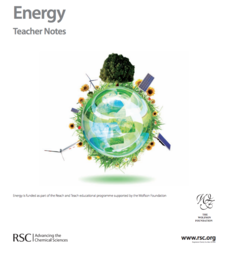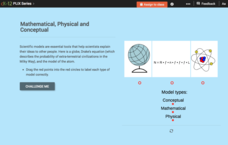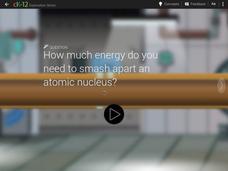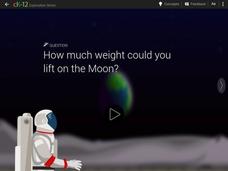Howard Hughes Medical Institute
Calculating Iridium Fallout from an Asteroid Impact
Should we be afraid of a large asteroid impact on Earth today? Young scientists estimate the size and composition of an asteroid similar to the one that caused the K-T mass extinction. They apply algebraic formulas to answer questions...
Physics Classroom
Work
Current work lesson plan just not ... working? Add an engaging interactive that helps pupils explore positive and negative work relationships! Individuals assess situations to determine what type of work, if any, the resource describes....
Physics Classroom
What's Up (and Down) with KE and PE
Physics class has its ups and downs ... especially when it involves energy concepts! Scholars analyze information to determine changes in kinetic and potential energy using an interactive resource. Realistic scenarios make connecting...
Physics Classroom
Energy Ranking Tasks
Here's an interactive with real potential ... potential energy, that is! Scholars analyze scenarios, then rank objects in order of greatest to least kinetic energy, potential energy, and speed. The interactive provides support materials,...
PBS
Student Helioviewer Data Tool
Scholars use current satellite data to view solar events, solar features, and so much more. It allows them to make videos over time to observe patterns and visually understand the sun at a much higher level using the interactive that is...
Physics Classroom
Charge and Charging
Does your class understand how things become charged? Are you positive? Before negative grades emerge, assign a fun interactive! The first in the five-part Static Electricity series contains three levels of charge-related questions and...
Kenan Fellows
Climate Change Impacts
Turn up the heat! Young mathematicians develop models to represent different climates and collect temperature data. They analyze the data with regression and residual applications. Using that information, they make conclusions about...
Royal Society of Chemistry
Energy—Gifted and Talented Chemistry
What has more energy than a room full of pupils after a fire drill? This lesson plan! Explore the changes in energy during different chemical reactions, discover why some reactions feel cold and others feel hot, and tackle the concept of...
Concord Consortium
Energy of a Spring
Spring has sprung! Young physicists explore the properties of springs with a simple simulator. Users control the initial position of the spring, then observe the potential, kinetic, and thermal energies in the system.
Concord Consortium
Energy of a Pendulum
Just a swingin'! Introduce physical science scholars to the energy forms associated with a pendulum using a simple interactive. Learners adjust the height from which the pendulum starts, then observe changes in potential, kinetic, and...
Concord Consortium
Gas Molecules in Motion
Get moving! Science scholars observe the effects of temperature on kinetic energy in an impactful interactive. Individuals control a sliding temperature switch and observe the motion of gas particles that results from the change.
Concord Consortium
Specific Heat and Latent Heat in Condensation
There's more to melting than meets the eye! Junior physical chemists investigate the differences between specific and latent heats as a substance undergoes a phase change. Users remove heat from the system and observe changes in kinetic...
CK-12 Foundation
Modeling: Mathematical, Physical and Conceptual
Scientific models help explain ideas and concepts to non-experts. The online activity covers conceptual, mathematical, and physical models. Through four multiple-choice questions and three discussion questions, scholars gain a deeper...
CK-12 Foundation
Scientific Models: Mathematical, Physical and Conceptual
This is one super model interactive! Middle and high school science scholars examine scientific models through a simple resource. Guided, hands-on practice allows them to classify conceptual, mathematical, and physical models. Other...
CK-12 Foundation
Energy Conservation Simulation
Does the amount of a roller coaster's energy change as it goes along the track? Scholars investigate when a roller coaster has potential and kinetic energy. They observe the changes as it goes up the initial hill follows it throughout...
CK-12 Foundation
Ski Jump
What are the three types of energy a ski jumper uses? If you said potential, kinetic, and heat, then you are correct. Scholars adjust the jumper's mass, jumper's form, and height of the start line in the simulation to display graphs of...
CK-12 Foundation
High Energy Particles
How much energy is required to break apart an atomic nucleus and does it vary based on the type of atom? Scholars virtually experiment with a linear accelerator in order to answer these questions. They alter the voltage, length of the...
CK-12 Foundation
Hot Oven
Why does the air in a hot oven not burn skin, but metal in the oven does? The simulation focuses on the difference between temperature and thermal energy and the way these are transferred. Scholars adjust the temperature of an oven and...
CK-12 Foundation
Trampoline
Does a trampoline use mostly potential or kinetic energy? Pupils adjust the mass of the jumper, stiffness of the trampoline, and initial jump height in order to answer that question. The simulation displays graphs of the various types of...
CK-12 Foundation
Block and Tackle
Can you easily lift more than your own weight? With a pulley system, almost anyone can manage this challenge. Scholars adjust the mechanical advantage (number of pulleys), weight of object being lifted, and the length of rope pulled. The...
CK-12 Foundation
Roller Coaster
Roller coasters rely on both kinetic and potential energy, but how much total energy does a roller coaster need? Scholars vary the mass of a coaster and the height of the initial hill. Graphs showing the types of energy and total energy...
CK-12 Foundation
Ramp and Piano
Can you lift a piano into a truck? Simulation allows scholars to explore the relationship between force, ramp length, and weight. Pupils control the variables of truck bed height, ramp length, weight of piano, and the number of friends...
CK-12 Foundation
Ballistics Tests
How did scientists measure the speed of incredibly fast things before the invention of high-speed photography? Scholars virtually perform ballistics tests to discover the process. They control the rifle type, bullet mass, and target...
CK-12 Foundation
Astronaut Training Chamber
Most people realize they would weigh less if they were on the moon, but does it change how much weight you could lift if you were on the moon? Scholars adjust the mass of an object to be lifted and select between four different locations...

























